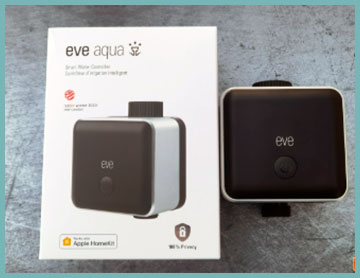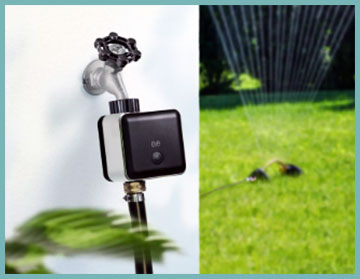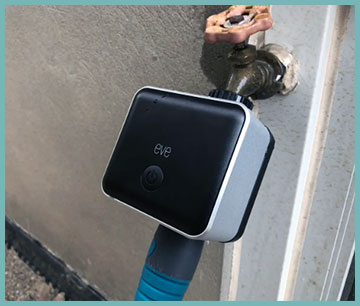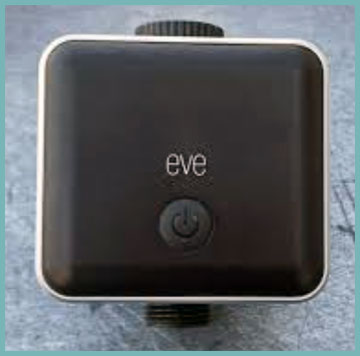I wanted to love the Eve Aqua Smart Water Controller. The promise of turning my outdoor faucet into a smart irrigation system, controllable via my iPhone or Siri, sounded like a gardener’s dream. Automating my garden’s watering while saving water?
Count me in! But after spending time with this device, I’ve got mixed feelings. While it has some solid features, its limitations and quirks make it hard to give it a full-throated endorsement. Let me walk you through my experience, break down the pros and cons, compare it to competitors, and share some maintenance tips to help you decide if it’s worth your investment.
My Experience with the Eve Aqua

I was thrilled when I first unboxed the Eve Aqua.
The sleek, matte black and space gray design looked modern, and the idea of controlling my garden’s watering from my couch or even while on vacation felt futuristic. Installation was a breeze—screw it onto my outdoor faucet, attach my hose, pop in the two AA batteries, and pair it with my iPhone via the Eve app.
Within minutes, I had it linked to Apple HomeKit, and I was ready to test it out.
The setup process was smooth, and I appreciated not needing a separate hub, as it connects via Bluetooth or Thread if you have a HomePod Mini or Apple TV 4K.
My backyard setup includes a drip irrigation system for my vegetable garden and a soaker hose for my flower beds. I set up a schedule in the Eve app to water my tomatoes and herbs daily at 6 a.m. for 20 minutes. The first few days were great—the Eve Aqua turned on right on cue, and I could check the app to confirm it ran.
I even used Siri to turn it on while I was sipping coffee, which felt like living in a sci-fi movie. The onboard button was handy, too, when I needed to water my lawn manually without pulling out my phone.
But then the cracks started to show. Connectivity issues cropped up, especially when I tried controlling it from inside my house, just 20 feet away. The Bluetooth range was spotty, and without a Thread network (I don’t own a HomePod Mini), I couldn’t rely on remote access unless I was practically standing next to it.
One morning, I noticed my garden was bone-dry because the schedule didn’t run—turns out, the device had unpaired from HomeKit overnight. Another time, it shut off after just 10 minutes instead of the programmed 30, leaving my plants parched. I also noticed a slight leak at the faucet connection, which a bit of Teflon tape fixed, but it was annoying for a $150 device. While the Eve Aqua has potential, these hiccups made me question its reliability for daily use.
Pros of the Eve Aqua

- Seamless Apple HomeKit Integration
If you’re an Apple ecosystem devotee like me, the Eve Aqua’s HomeKit compatibility is a big win. It pairs effortlessly with your iPhone, iPad, or Apple Watch, and you can control it with Siri voice commands. Saying, “Siri, water the garden,” and watching the system kick on is undeniably cool. The Eve app also lets you set up to seven daily watering schedules, which are stored on the device itself, so they run even if your internet goes down. This autonomy is a lifesaver if you’re in an area with spotty Wi-Fi.
- Thread Support for Future-Proofing
The third-generation Eve Aqua supports Thread, a low-power mesh network that promises better range and reliability than Bluetooth. If you’ve got a HomePod Mini or a newer Apple TV, you can tap into this network, making the device more responsive. I didn’t have a Thread-compatible hub during my testing, but I love that Eve is planning to support Matter, the emerging smart home standard. This could make the Eve Aqua more versatile down the road, especially if you want to integrate it with non-Apple devices.
- Easy Installation and Compatibility
Setting up the Eve Aqua is as simple as screwing it onto your faucet and attaching your hose or irrigation system. It’s compatible with standard 3/4-inch hose fittings and works with popular brands like Gardena and Kärcher. I used it with my Hozelock drip system, and it fit perfectly. The included quick-connect adapter is a nice touch, though you’ll need the female end for it to be useful. The device’s IPX4 water resistance and UV protection also mean it can handle outdoor conditions, from scorching summers to rainy springs.
- Water Usage Tracking
One feature I appreciated was the Eve app’s water usage estimation. By inputting your irrigation system’s flow rate (I used a bucket and stopwatch to measure mine), the app calculates how much water you’re using daily. This helped me realize I was overwatering my herbs, so I adjusted the schedule to save water. It’s not a precise flow meter, but it’s a handy way to keep tabs on consumption, especially if you’re trying to be eco-conscious.
- Quiet Operation
Unlike older models, which some users complained were noisy, the third-generation Eve Aqua uses a magnetic valve that’s nearly silent. I barely noticed it running, which is great if your faucet is near a patio where you relax. This upgrade makes it less intrusive than competitors like the Orbit B-Hyve, which can be a bit clunky and loud.
Read More: My Thoughts On Waterboss Proplus 380
Cons of the Eve Aqua
- Apple-Only Ecosystem
The biggest drawback is that the Eve Aqua is exclusively for Apple users. If you’re on Android or use Alexa or Google Assistant, you’re out of luck. This walled-garden approach feels restrictive, especially when competitors like Orbit B-Hyve work with both iOS and Android, plus integrate with Alexa and IFTTT. I have friends with mixed smart home setups, and they’d be frustrated by the Eve Aqua’s Apple-only stance.
- Spotty Connectivity
Bluetooth connectivity is a double-edged sword. It’s power-efficient, meaning the AA batteries last up to five months, but the range is abysmal—often less than 15 feet if walls are in the way. I had to walk outside with my phone to reconnect when it dropped. Thread support helps if you have the right hub, but without it, you’re stuck with Bluetooth’s limitations. I’ve read reviews of users experiencing unpaired devices or schedules failing, and I ran into similar issues, which eroded my trust in the device.
No Built-In Weather Awareness
For a device touting water conservation, the lack of native weather integration is baffling. Competitors like Orbit B-Hyve and Rachio automatically skip watering if rain is forecast, but the Eve Aqua relies on a clunky Siri Shortcut to pause schedules based on weather. Setting it up was a hassle, and it’s not foolproof—I missed a watering session because the shortcut didn’t trigger. This feels like a missed opportunity for a smart device in 2025.
- Leaks and Build Quality Concerns
While the third-generation model has a brass fitting to reduce leaks, I still noticed drips at the faucet connection. Tightening it and adding Teflon tape helped, but it’s frustrating for a premium-priced device. Some Amazon reviews also mention the plastic body feeling cheaper than the older aluminum versions, and I agree—it doesn’t feel as sturdy as I’d expect for $150. There’s also the risk of the device detaching under high water pressure, which could lead to flooding if you’re not home.
- Limited Home App Functionality
The Apple Home app is bare-bones for controlling the Eve Aqua. You can turn it on or off and set a default runtime, but scheduling and advanced features are locked behind the Eve app. I found the Eve app’s interface clunky, with the scheduling feature buried in menus. It took me days to figure out how to set up multiple daily watering periods. This reliance on a third-party app for core functionality feels like a step backward compared to competitors with more intuitive apps.
Maintenance Tips for the Eve Aqua

- Regularly Check Connections for Leaks
To avoid water wastage, inspect the Eve Aqua’s connections to your faucet and hose monthly. I noticed a slight drip at the top fitting, which I fixed with Teflon tape. Wrap the tape tightly around the threads before screwing the device on to ensure a snug fit. If you’re using a high-pressure system, consider adding a Gardena auto-stop quick-connect to prevent the device from detaching and causing a flood. This extra step saved me from potential disasters.
- Winterize the Device
If you live in a region with freezing winters, remove the Eve Aqua before the first frost. Water left inside can freeze and crack the valve, rendering it useless. I store mine in a dry, indoor spot during the off-season, with the batteries removed to prevent corrosion. Before storing, rinse the device to remove dirt or debris, and check the O-ring in the battery compartment for wear—replace it if it’s damaged to maintain water resistance.
- Monitor Battery Life
The Eve Aqua runs on two AA batteries, which last about five months with regular use. Check the battery level in the Eve or Home app monthly to avoid unexpected failures. I set a calendar reminder to swap batteries at the start of the gardening season. Use high-quality alkaline batteries, as cheaper ones may not last as long. To change them, slide open the battery compartment, pop out the old ones, and insert new ones, ensuring the polarity matches the markings.
- Clean the Valve and Fittings
Dirt and sediment can build up in the valve or fittings, especially if your water source isn’t pristine. Every couple of months, unscrew the Eve Aqua and rinse the brass fitting and valve with clean water. I used a soft brush to gently scrub away grime without damaging the threads. This keeps the magnetic valve operating smoothly and prevents clogs that could affect water flow.
- Update Firmware Regularly
Eve occasionally releases firmware updates to improve connectivity and performance. Check the Eve app under Settings > Accessories for updates. I missed an update early on, which might’ve contributed to my connectivity woes. Updating takes a few minutes and requires a stable Bluetooth connection, so stand close to the device. These updates can fix bugs and enhance Thread compatibility, so don’t skip them.
Comparison with Other Brands

Let’s talk about how the Eve Aqua stacks up against competitors like the Orbit B-Hyve, Rachio Smart Hose Timer, and Meross WiFi Water Timer. I’ve tested the B-Hyve and researched the others to give you a clear picture.
- The Orbit B-Hyve: is a standout for its affordability—around $60 compared to the Eve Aqua’s $150. It works with both iOS and Android, supports Alexa and IFTTT, and has a killer feature: automatic weather adjustments. If rain’s coming, it skips watering, no Siri Shortcuts required. I loved how the B-Hyve app let me fine-tune schedules based on soil type and plant needs. However, it requires a separate Wi-Fi hub, which adds bulk, and its plastic build feels less premium than the Eve Aqua’s. It’s also noisier when operating, which bugged me when I was relaxing outside.
- The Rachio Smart Hose Timer: priced around $100, is another strong contender. Like the B-Hyve, it uses a Wi-Fi hub for better range than the Eve Aqua’s Bluetooth or Thread. Its app is intuitive, with weather intelligence that adjusts schedules based on local forecasts. I found Rachio’s setup slightly more involved than the Eve Aqua’s, but its reliability was rock-solid, and it supports Alexa, Google Assistant, and HomeKit. The downside? The hub and valve feel a bit flimsy, and you’ll need an outlet nearby for the hub, which isn’t ideal for all setups.
- The Meross WiFi Water Timer: at about $50, is a budget-friendly option that supports HomeKit, Alexa, and Google Assistant. It’s Wi-Fi-based, so no range issues, and it has a brass inlet and outlet for durability. The app is straightforward, with weather-based skip features similar to B-Hyve and Rachio. However, some users report connectivity drops with spotty Wi-Fi, and the build quality isn’t as polished as the Eve Aqua’s. I haven’t tested it personally, but reviews suggest it’s a solid pick for mixed smart home setups.
The Eve Aqua shines for Apple diehards who value HomeKit integration and don’t mind the price tag. Its Thread support and quiet operation are big pluses, but its Apple-only compatibility, spotty Bluetooth range, and lack of native weather awareness make it less versatile than the B-Hyve, Rachio, or Meross. If you’re not locked into Apple’s ecosystem or need reliable remote access, the competitors offer better value and functionality.
Why I’m Hesitant to Recommend the Eve Aqua
After weeks of testing, I can’t fully recommend the Eve Aqua. Its HomeKit integration, Thread support, and easy setup are fantastic for Apple users, but the connectivity issues, lack of weather awareness, and premium price tag hold it back. For $150, I expected rock-solid reliability, but the Bluetooth range and occasional schedule failures left me frustrated. Competitors like Orbit B-Hyve and Rachio offer more features, broader compatibility, and lower prices, making them better choices for most gardeners. If you’re deep in the Apple ecosystem and have a Thread-compatible hub, the Eve Aqua might work for you—just be prepared for some quirks.
Read More: My Thoughts On DuPure Water Softener
Frequently Asked Questions (FAQ)
The Eve Aqua is a smart water controller that screws onto your outdoor faucet, connecting your hose or irrigation system. It uses Bluetooth or Thread to communicate with your iPhone, iPad, or Apple Watch via the Eve app or Apple Home app. You can turn the water on or off manually with a button, via the app, or using Siri voice commands. Schedules set in the Eve app are stored on the device, running autonomously without needing an internet connection. A home hub (HomePod, HomePod Mini, or Apple TV) is required for remote access.
The Eve Aqua uses a standard 3/4-inch (26.5 mm or G 3/4″) thread, compatible with most outdoor faucets and popular hose systems like Gardena or Kärcher. It includes a quick-connect adapter for hoses, but you’ll need the matching female connector for it to work. Always check your faucet’s thread size before purchasing to ensure a proper fit.
To automate the Eve Aqua, open the Eve app, go to Settings > Accessories, and select your Eve Aqua. Tap “Schedules” to set up to seven daily watering periods, choosing start times, durations, and days of the week. You can also use Siri Shortcuts to pause schedules based on weather forecasts, though this requires setup in the Shortcuts app. For remote automation, ensure you have a HomePod, HomePod Mini, or Apple TV as a home hub. Schedules are stored on the device, so they run even without internet.
To change the Eve Aqua’s batteries, slide open the battery compartment on the bottom of the device. Remove the two AA batteries and replace them with new, high-quality alkaline batteries, ensuring the polarity (+/-) matches the markings inside. Close the compartment securely to maintain water resistance. Check the O-ring for wear and replace it if damaged. The Eve app or Home app displays battery levels, so monitor them regularly to avoid interruptions.
Conclusion
After weeks of hands-on time with the Eve Aqua Smart Water Controller, I’m left torn. Its seamless Apple HomeKit integration, Thread support, and sleek design make it appealing for Apple enthusiasts like me who want a smart irrigation solution. The ability to schedule watering and track usage via the Eve app is handy, and the quiet operation is a nice touch. However, the spotty Bluetooth connectivity, lack of native weather awareness, and occasional leaks were dealbreakers. For $150, I expected flawless performance, but issues like schedules failing and the Apple-only ecosystem make it hard to justify over competitors like Orbit B-Hyve or Rachio, which offer more features and broader compatibility at lower prices. If you’re all-in on Apple and have a Thread-compatible hub, the Eve Aqua might work, but for most gardeners, there are better, more reliable options out there. Weigh your needs carefully before buying—this device has potential but doesn’t fully deliver.
